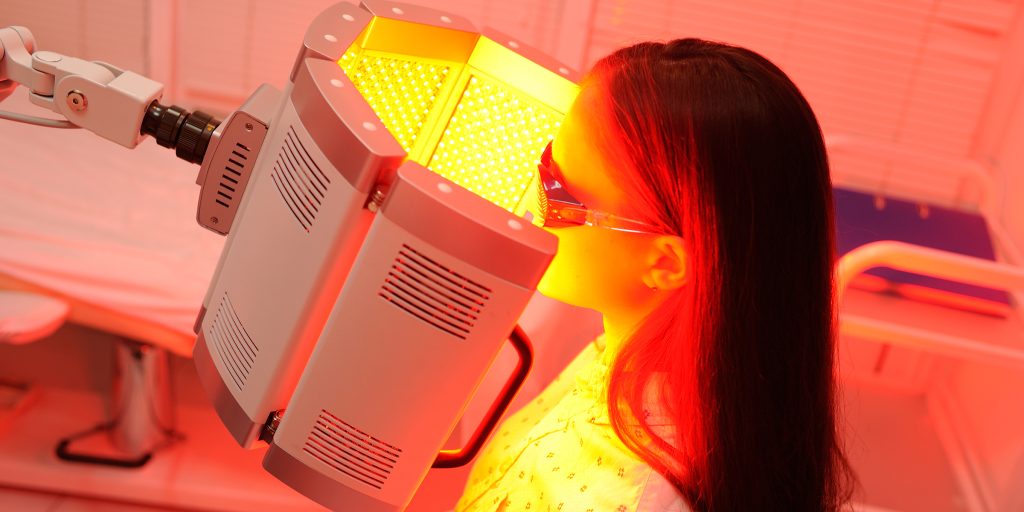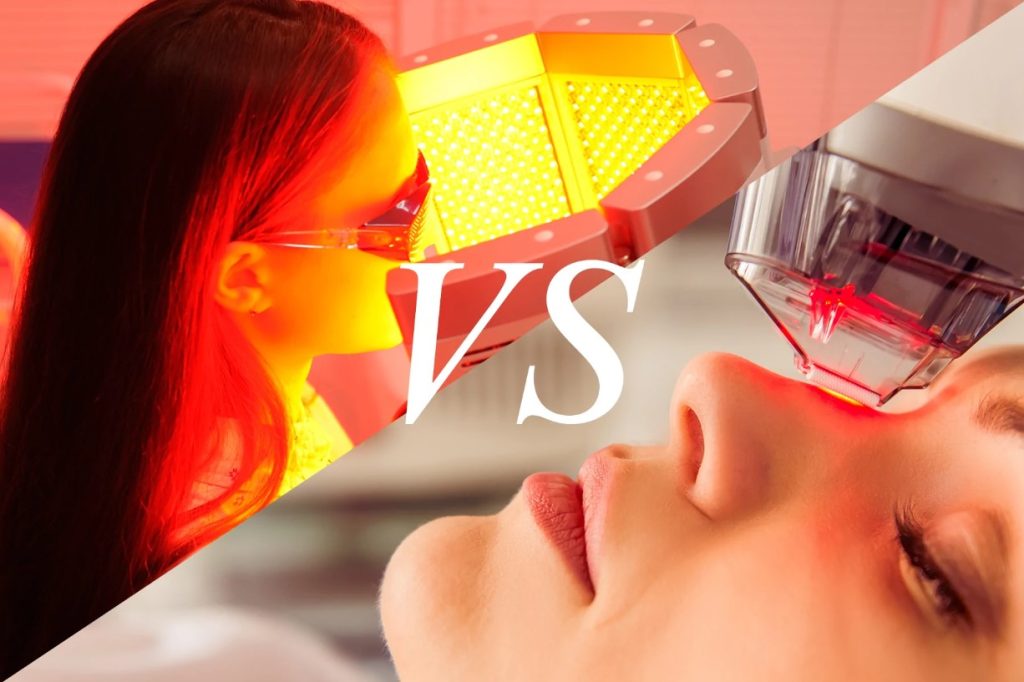Red light therapy has recently become popular for achieving healthy-looking skin, but what about using it after laser treatment? Can I use red light therapy after laser treatment? Is it possible for RLT to reduce the redness of the laser?
The low wavelength of red light is known that might improve people’s skin appearance, such as scars, redness, wrinkles, and acne.
However, people also utilize laser treatments, and many search the Internet on whether they can use RLT right after the treatment. Thus, without any further ado, let’s get started and discover the answer and more!

Source: shutterstock.com
Can I Do Red Light Therapy After Laser Treatment?
Red light therapy affects our skin’s cells and might strengthen the mitochondria. Therefore, energy gets generated and might bring many positive benefits. With more energy, these cells might function better, repair damage, and rejuvenate themselves.
Red light therapy is different from lasers because it doesn’t cause any damage to the skin. Lasers cause controlled damage to our skin’s outer layer, which induces tissue repair. Doing red light therapy might bypass this harsh step by possibly stimulating the skin to regenerate.
So, the answer to whether you can do red light therapy after laser treatment is yes; you can do it. It is shown to possibly regulate the inflammatory process without causing adverse effects. If you do decide to use RLT after laser treatment, we recommend you use it at least several hours after the laser treatment to prevent any mild side effects.
Using RLt after laser treatment may possibly reduce pain and swelling and promote the healing of damaged tissues after the laser treatment. Thus, let’s see more about it in the section below!
Red light therapy post-laser treatment
There may be a reason why you should avoid using red light therapy directly after laser treatment.
Red light therapy is used to possibly promote new hair growth and help thin hair, but once the laser has removed the hair, red light therapy is not that strong and doesn’t penetrate the skin down to the hair follicle to cause the hair to grow back.
It may be most optimal to start red light therapy a couple of days after laser treatment to heal the skin. Red light therapy doesn’t emit any ultraviolet light; thus, it is nothing like a tanning bed or any other treatment that uses UV light. Ultraviolet light should be avoided after laser treatment, which means that red light is acceptable.
Using a red light LED device for the face may be the most beneficial after your skin has completely peeled from the laser treatment. After the peeling, you might see promising results. The result you receive from the laser depends just as much on the device you use and how frequently you use it.
Red light therapy and infrared LEDs, such as a face mask device, might decrease skin inflammation after laser treatments, so this might help you heal better.

Source: drdennisgross.com
Difference Between Red Light and Laser Treatment
LED and lasers both use light energy. The difference is the intensity and the strength of the particular beam they each let out. The term “LED” stands for light-emitting diode, and they are a way to deliver a special type of red light and blue light.
Red light therapy might greatly stimulate collagen. Collagen is the protein fibers in the skin that make the skin thick and firm. We lose collagen when we get fine lines, wrinkles, etc.
You can use many devices at home to do red light therapy, such as a micro-needling device, a smart mask tool, and hair removal devices. All of these devices are entirely safe.
Suppose you have a problem with fine lines and wrinkles around the eyes or inflammation on the skin after undergoing laser treatment. In that case, you will be able to find a device that covers that area and possibly promote healing.
Laser hair removal is a procedure people go through if they want to get rid of unwanted hair. This procedure uses a concentrated beam of light to remove the hair.
During the treatment, the laser emits a light that gets absorbed by the pigment in your hair. This light energy gets turned into heat, damaging the tube-shaped follicle in your skin that makes the hair grow.
Laser vs. LED
Lasers let out a coherent and monochromatic light. This means they are a single-color wavelength, and the light waves are emitted in phases.
Because lasers have a single wavelength, it possibly makes them ideal for medical treatments. Some tissues, including our hair follicles, only work to a particular type of light wavelength.
Due to the laser light’s coherence, the energy gets focused in one place, and the beam remains narrow. This is great as it effectively penetrates deep into your skin and reaches the hair follicles.
On the other hand, LED light emits a range of wavelengths instead of one specific wavelength. LED lights emit incoherent beams and are broader than the laser, so they cannot penetrate far into the skin.
However, the wavelengths are enough to prompt a certain reaction in the skin that might promote healing of the inflamed area after laser treatment.
Also read: Can Red Light Therapy Cause Hair Loss?
Conclusion
We hope we have provided enough helpful information regarding whether can I do red light therapy after laser treatment.
Red light therapy is a safe treatment that won’t interfere with your skin after laser treatment since it doesn’t emit ultraviolet light. It might be very soothing to the skin, especially if you are feeling discomfort, and it might also have a calming effect.
It might also enhance DNA synthesis and augment the cell tissues to regenerate. Depending on which wavelength gets utilized, going under a series of red light therapy sessions after a laser treatment might help your skin accelerate wound healing, rejuvenate and make it firmer, and even treat precancerous lesions.
You won’t need to worry about new hair growth, as red light therapy won’t penetrate your skin as deep as the laser treatment.
However, you should always consult with a professional before utilizing any such therapy due to your overall health!

Hello! I’m Nicky Rodgers.
Almost a decade ago, I got excited about the idea of employing alternative methods like red light therapy to create a healthier life.
To learn more about it, I did my Certified Light Therapist course from Photonic Therapy Institute and started looking into the intricacies of how light therapy influences several bodily processes. Before I knew it, my interest had become an obsession which resulted in this extensive blog.
Here, I offer countless well-researched articles to help you understand the benefits and uses of light therapy. I hope this information gives you a head start in your wellness journey.
